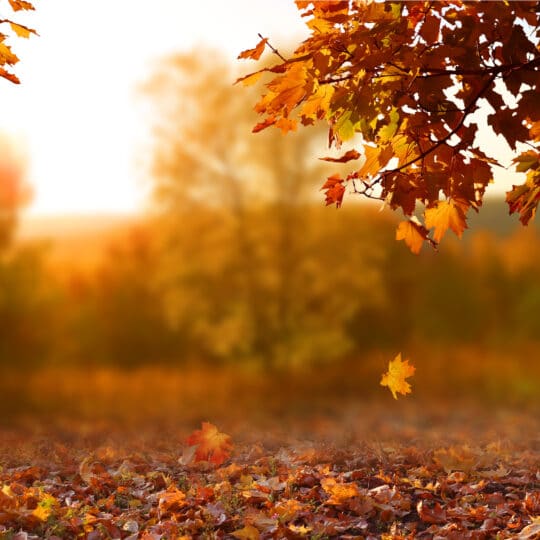Guide to Fall Tree Care
What to Focus on this Season
Posted
September 9, 2021

Now that it’s (unofficially) fall, visions of pumpkins and apples start to surface. We start to look toward the trees for their gradual transformation from green to vivid shades of red, orange, and yellow. Of course, as these beauties start to fall to the ground, they become a little less wonderful, especially if you’re tasked with raking them up. Here’s a handy fall tree care guide for more maintenance tips and what to do with all those leaves.
Fall Tree Care Guide
Taking care of your tree is important in any season. Proper maintenance helps keep it healthy all year and strong enough to withstand harsh seasons, like summer and winter. Now that your tree made it through the heat, you need to prepare it for the cold. As it starts to lose its leaves, it gives you the perfect opportunity to check it out more thoroughly. While pruning anything but dead and broken branches should wait another season, there’s plenty to do in the fall.
Don’t Leave the Leaves
Depending on the type and size of tree you have, you could potentially have a lot of leaves to deal with. Letting them pile up on the grass is not good for you or your lawn. Large piles of wet leaves provide perfect conditions for fungal disease. While you don’t have to rake them all up and throw them away, you can use your mower to mulch them and provide your yard with natural fertilizer or add the leaf-made mulch to your compost pile.
Also, this is a great time to check your gutters. Just like on the ground, the leaves up there are more likely to remain wet, invite disease, and create poor drainage that could cause more damage to your home.
Get the Roots Ready
Many trees show signs of certain conditions in the trunk, branches, and leaves. But sometimes you have to get to the root of the problem. Tree roots need just as much care as tree leaves and branches. One of the best ways to provide roots with what they need is to fertilize. When you fertilize in the fall, you help prepare your tree for a winter without enough nutrients.
The tree in your yard is not like the trees out in the woods. Nature takes care of those by providing a natural fertilizer of leaves, twigs, and bark. You can make the same nutrient-rich cocktail for your tree by mulching your leaves and yard debris and adding it to a compost pile
If you don’t have compost, you can also apply a store-bought fertilizer to the area around the roots. Then you want to add mulch as well. This insulates the roots and protects them from the coming cold. It also helps the area retain moisture and the fertilizer you just applied to feed and water the tree.
More on Fall Mulching
You may have added a layer of mulch to your gardens in the spring to help combat weeds. Well, it’s a good time for another layer. Here are a few reminders:
- Refresh any old layer of mulch by raking it loose. Laying a new layer on top of compacted mulch won’t be as effective.
- For young trees, spread mulch as far out as the canopy reaches. If you’re standing under the tree, look up. See branches? Apply mulch to the area around you. Go out as far as you can go until you don’t see the tree branches when you look up. If this tactic will end up covering your entire yard with mulch, simply focus on a two-foot radius around the tree instead.
- The layer of mulch should be approximately two to four inches deep.
- Stay away from the trunk of the tree. Don’t pile mulch up in this area or you may attract insects and disease.
Fall Tree Watering Guide
If you thought keeping your trees hydrated this summer was tough, your job isn’t done just yet. Trees still get dehydrated in the winter. You want to focus on watering the roots to get them good and ready. Leave the leaves alone (they’re falling off anyway). The same watering rules apply:
- Water in the morning to prevent excessive evaporation.
- Water deeply.
- Keep the soil moist, not soaking.
Call in the Reinforcements
If you notice the physical structure of your otherwise healthy tree is compromised, you may be able to help stabilize it with cabling techniques. Cabling can’t help dying trees, they have more problems than a brace can fix. Before a winter storm puts more pressure on your tree, get it checked out by an arborist to see if cables can help.
Welcome New Fall Trees
The cooler temperature of fall is a great time to plant a new tree. Any newbies need more water than more established trees, but when fed and mulched properly, they can survive the winter and thrive in the spring.
Professional Fall Tree Care Guide
For more information on proper fall tree care, contact Elite Tree Care. From mulching to planting, we can help guide you to get your trees in shape for any season.

Download Your FREE Tree Planting Guide
Planting a tree is a cinch, as long as you are properly prepared. Get prepped to plant one tree or 100 with our straightforward guide.